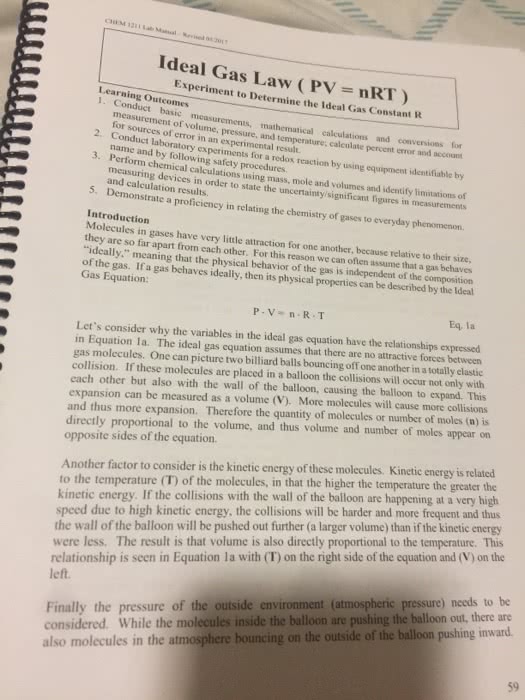CHEM1010 Final: CHEM1010 Course Summary

Introduction to Atomic and Molecular Concepts
Chemistry is the science of explaining and quantifying observable macroscopic phenomena
and properties in terms of microscopic structure and interactions.
Be able to distinguish between elements, compounds and mixtures in terms of its
physical state and composition
Chemistry is the study of matter, but matter is complicated. Matter can exist in 3 states:
1. Gas: no fixed volume or shape and therefore will adopt the volume and shape of its
container.
2. Liquid: distinct volume but no specific shape.
3. Solid: distinct volume and shape.
The state matter exists in is dependent on the surrounding temperature and pressure. E.g.
water will boil at room temperature if the pressure is low enough. Plasma is the 4th state of
matter, produced by heating gas or subjecting gas to intense electromagnetic fields. Plasma
has no fixed volume or shape and is composed entirely of ions.
Properties of Matter
To determine different types of matter we can describe its state, size, shape colour,
measure its mass and volume, ductility (how well it stretches), malleability (how well it
deforms) and lustre (how shiny it is). Quantitatively we can measure hardness (the Mohs
scale), boiling point (ºC, K), melting point (ºC, K), solubility (mass per unit volume), thermal
conductivity (W m-1 K-1) and electrical conductivity (A2 s3 m-3 kg-1).
Elements
- Made up of atoms which are the fundamental
particles of chemistry
- Pure substances i.e. all atoms of a chemical element
are indistinguishable from each other
Compounds
- Pure substances that consist of two or more chemical elements combined chemically
in definite proportions e.g. water has oxygen and hydrogen atoms bound together in
a ratio of 1:2 and sodium chloride has sodium and chlorine atoms bound together in
a ratio of 1:1.
Mixtures
- A mixture is a non-chemical combination of two or pure gas, liquid or solid
substances
- Mixtures can consist of multiple phases e.g. Granite is made up of quartz, feldspar
and hornblende (all solid), face creams are made of solids and liquids, vinaigrette is
made up of oil and vinegar (all liquid) and air which is made up of O2 and N2 (all gas)
Solution
- A solution is a homogenous mixture
- Any part of a solution is indistinguishable from all other parts

- Solutions can be solid, liquid or gas, but consist of only a single phase e.g. and air
which is made up of O2 and N2, petrol is octane and butane, 3-ethyltolune and bronze
is tin and copper
Be able to use significant figures, scientific notation and SI units for numbers and
measurements
Unit: a specific standard quantity of a particular property, against which all other quantities
of that property can be measured.
There are 7 fundamental units in the SI unit system.
Length (metres, m)
Mass (kilogram, kg)
Temperature (kelvin, K)
Time (second, s)
Amount of substance (mole, mol)
Electrical Current (ampere, A)
Luminous intensity (candela, cd)
Non SI units are also commonly accepted:
- Temperature: ºC instead of SI unit kelvin (K).
- Pressure: atmospheres (atm), torr, bar, mm of mercury (mm Hg), instead of SI-
derived unit Pascal (Pa). 1 Pa = 1 kg m / s2.
- Density: g/cm3, instead of SI-derived unit kg / m3.
- Volume: litres (L), millilitres (mL), instead of SI-derived unit m3.
- Length: Angstrom (Å = 10-10 m), instead of SI unit metres (m). Used mostly for
describing distances of atoms, molecules.
- Energy: Calorie (cal), electron volt (eV), wavenumber (cm-1) instead of SI-derived unit
Joule (J). 1 J = kg m2 / s2.
- “CGS units”: centimeters, grams, seconds.
Matter Is it
uniform
?
Heterogeneous
mixture
Homogeneous
substance
Does it have
variable
composition
?
Homogeneous
mixture (solution)
Pure
substance
Can it be
separated
into
simpler
substance
s?
Element
Compound

Know and be able to interconvert between the common prefixes used to modify the
scale of standard units
Common prefixes for SI units
Prefix
Symbol
Factor
Tera
T
1012
Giga
G
109
Mega
M
106
Kilo
K
103
Deci
d
10-1
Centi
c
10-2
Milli
m
10-3
Micro
μ
10-6
Nano
n
10-9
Pico
p
10-12
Femto
f
10-15
Be able to interconvert between the Celsius (°C) and Kelvin (K) temperature scales
To convert ºC ➝ K, add 273.15.
To convert K ➝ ºC, subtract 273.15.
e.g. what is 80.1 ºC in Kelvin?
80.1 +273.15 = 353.25 K
Be able to perform calculations involving the relationship between density, mass and
volume including appropriate conversion of units
𝑝 = 𝑚
𝑣 where p is the density, m is the mass and v is the volume.
The standard unit of density is km/g3, the standard unit for mass is kg and the standard unit
for volume is m3.
Describe the basic postulates of Dalton's atomic theory
Antoine Lavoisier found that during a chemical reaction, no detectable gain or loss of mass
occurs - mass is conserved, this is the law of conservation of mass. Joseph Louis Proust
proposed the law of definite proportions, in any chemical compound, elements are
combined in the same proportions by mass. The law of definite proportions is based on
mass, since Proust had no concept of atoms.
e.g. If 2.00 grams of a substance is found to contain 0.93 grams of iron, and 1.07 grams of
sulfur, how much sulfur is present in another sample of the same compound having 4.19
grams of iron?

